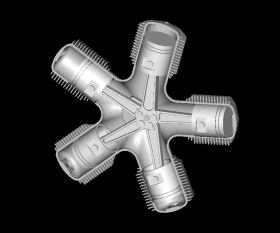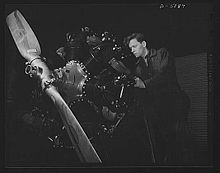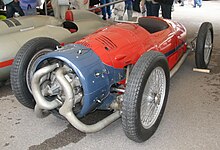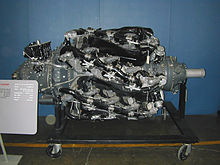Radial engine
This article needs additional citations for verification. (September 2007) |


The radial engine is a reciprocating type internal combustion engine configuration in which the cylinders point outward from a central crankshaft like the spokes on a wheel. This configuration was very commonly used in aircraft engines before being superseded by turboshaft and turbojet engines.
In a radial engine the pistons are connected to the crankshaft with a master-and-articulating-rod assembly. One piston has a master rod with a direct attachment to the crankshaft. The remaining pistons pin their connecting rods attachments to rings around the edge of the master rod (see animation). Four-stroke radials almost always have an odd number of cylinders, so that a consistent every-other-piston firing order can be maintained, providing smooth running.
History


Charles Manly constructed a water-cooled 5 cylinder radial engine in 1901, a conversion of one of Stephen Balzer's rotary engines, for Langley's Aerodrome aircraft. Manly's engine produced 52 hp (39 kW) at 950 rpm.[1]
In 1903-04 Jacob Ellehammer used his experience of constructing motorcycles to build the world's first air-cooled radial engine, a 3-cylinder engine which he used as the basis for a more powerful 5-cylinder model in 1907, which he installed in his triplane and which made a number of short free flight hops. During 1908-9 Ellehammer developed another engine, which had 6 cylinders arranged in two rows of three. His engines had a very good power-to-weight ratio but his aircraft designs suffered from his lack of understanding of control. If he had concentrated on his engines he might have become a successful manufacturer.[2]
Another early radial engine was the 3-cylinder Anzani, one of which powered Louis Blériot's Blériot XI in his 1910 crossing of the English Channel. By 1914 Anzani had developed their range, with their largest radial being a 20-cylinder engine of 200 hp (150 kW), with its cylinders arranged in four groups of five.[1]
The radial engine was not developed in Germany; two radial engines were made in Germany before World War I, but the Germans seemed to lose faith in the type under war conditions, or it may have been that insistence on standardisation ruled out any but proven engine types.[1]
Radial versus inline debate

There was a debate about the merits of radial versus inline engines after World War I which continued throughout the 1930s, with both types seeing use. The radial was more popular largely due to its simplicity, and most navy air arms had dedicated themselves to it because of its improved reliability for over-water flights and better power/weight ratio for aircraft carrier takeoffs. Although inline engines offer smaller frontal area than radials, inline engines require the added weight and complexity of cooling systems and are generally more vulnerable to battle damage; damage to an inline engine could result in a loss of coolant and consequent engine seizure, while an air-cooled radial could take damage but continue to operate.[3] A significant advantage of the air-cooled radial is that all cylinders receive equal cooling airflow.
Another advantage is that by being flat, radial engines resulted in shorter aircraft with a smaller moment of inertia that were able to turn more tightly. This was especially important in fighter aircraft.
The vast majority of radial-engined aircraft designed since the 1930s were also fitted with NACA cowlings to reduce drag and to also enhance forward thrust by virtue of its airfoil effect.
The Wright company's J-5 Whirlwind radial engine of 1925 was billed as "the first truly reliable aircraft engine". Wright employed Giuseppe Mario Bellanca to design an aircraft to showcase it, and the result was the Wright-Bellanca 1, or WB-1, which was first flown in the latter part of that year. The J-5 was used on many advanced aircraft of the day, including Charles Lindbergh's Ryan NYP.
Multi-row radials

Originally radial engines had one row of cylinders, but as engine sizes increased it became necessary to add extra rows. Most did not exceed two rows, but the largest radial engine ever built in quantity, the Pratt & Whitney Wasp Major, was a 28-cylinder 4-row radial engine used in many large aircraft designs in the post-World War II period. The USSR also built a limited number of 'Zvezda' engines with up to 56 cylinders. The 112-cylinder diesel boat engines featuring 16 rows with 7 banks of cylinders, bore of 160 mm (6.3 in), stroke of 170 mm (6.7 in), and total displacement of 392 liters (23,931 in³). The engine produced 10,000 hp (7,500 kW) at 2,000 rpm.
Modern radials
At least three companies build radials today. Vedeneyev engines produces the M-14P model, 360 hp (270 kW) radial used on Yakovlevs, and Sukhoi Su-26 and Su-29 aerobatic aircraft. The M-14P has also found great favor among builders of experimental aircraft, such as the Culp's Special, and Culp's Sopwith Pup [1], Pitts S12 "Monster" and the Murphy "Moose". 110HP 7-cylinder and 150HP 9-cylinder engines are available from Australia's Rotec Engineering. Miniature radial engines for model airplane use are also available from OS and Saito of Japan and Technopower. The Saito firm is known for making three different sizes of three-cylinder radials, and a five-cylinder example.
Diesel radials
While the vast majority of radial engines have been produced for gasoline fuels, there have been instances of diesel powered engines. The Bristol Phoenix of 1928-1932 was successfully tested in aircraft and the Nordberg Manufacturing Company of the US developed and produced a series of large radial diesel engines from the 1940s.
To reduce the chance of engine fires, in 1932 the French company Clerget developed the 14D, a 14-cylinder 2-stroke diesel radial engine. After a series of improvements, in 1938 the 14F2 model produced 520 hp (390 kW) at 1910 RPM cruise power, with a power-to-weight ratio near that of contemporary gasoline engines and a specific fuel consumption of 166g/hp/hour. During WWII the research continued, but no engines were mass-produced because of the Nazi occupation, and by 1943 the engine had grown to produce over 1000 HP with a turbocharger. After the war, the Clerget company was integrated in the SNECMA company and had plans for a 32-cylinder diesel engine of 4,000 hp (3,000 kW), but in 1947 the company abandoned piston engine development in favor of work on the emerging turbine engines.
The Nordberg engines were initially designed for electricity production in aluminium smelters. They differed from the norm of radial design by using two opposite cylinders as a double master instead of the more usual single master rod, and managed to run perfectly circular. The engine design also permitted even numbers of cylinders in a single row with the cylinders being fired in consecutive order. The engines were a two-stroke design and were also available in a dual-fuel gas/diesel model. A number of powerhouse installations utilising large numbers of these engines were made in the US.[4]
See also
References
- ^ a b c Vivian, E. Charles (1920). A History of Aeronautics. Dayton History Books Online.
{{cite book}}: Cite has empty unknown parameter:|coauthors=(help) - ^ Day, Lance (1996). Biographical Dictionary of the History of Technology. Taylor & Francis. p. 239. ISBN 0415060427.
{{cite book}}: Unknown parameter|coauthors=ignored (|author=suggested) (help) - ^ Thurston, David B. (2000). The World's Most Significant and Magnificent Aircraft: Evolution of the Modern Airplane. SAE. p. 155. ISBN 076800537X.
{{cite book}}: Cite has empty unknown parameter:|coauthors=(help) - ^ "Nordberg Diesel Engines". OldEngine. Retrieved 2006-11-20.
{{cite web}}: External link in|publisher=
